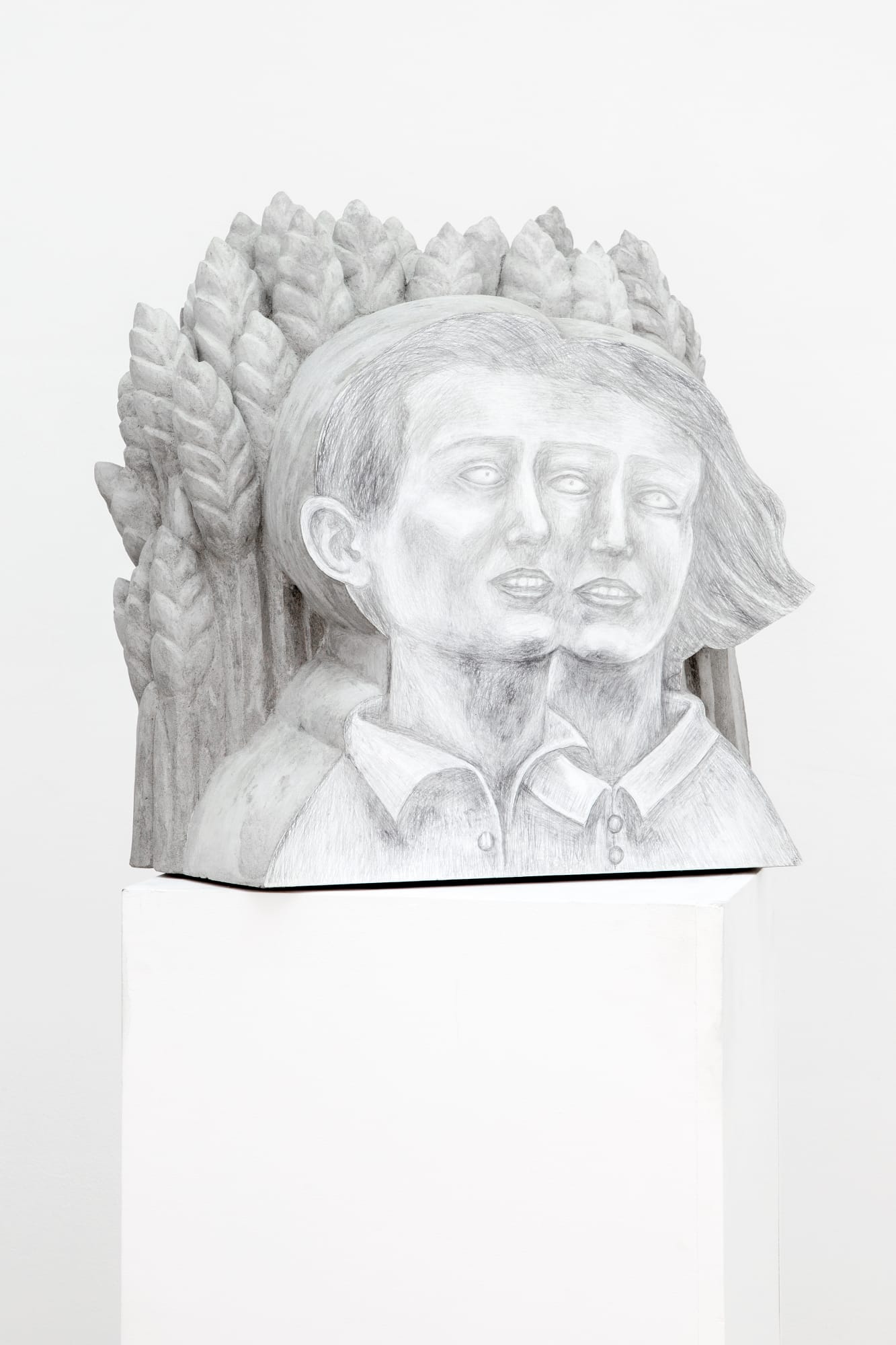-
Anna Hulačová
The Collectivists, 2019Concrete and pencil drawing on a metal sheet49 x 52 x 33 cm
19 1/4 x 20 1/2 x 13 in.Courtesy Hunt Kastner.A certain religiosity is contained in the oeuvre of Anna Hulačová. She previously worked with linden wood and honeycombs, and at present makes sculptures of concrete and complements them with...A certain religiosity is contained in the oeuvre of Anna Hulačová. She previously worked with linden wood and honeycombs, and at present makes sculptures of concrete and complements them with drawing in pencil. Hulačová herself says about her sculptures: ‘There is an internal contradiction manifested by the material contrast between the contradictions of wet/dry, flat/curved, historical/futuristic, gentle/brutal.’
Hulačová’s imaginary figures have faces that are usually covered by the masks that make up their characters. In the bodies of these organisms, whose forms are transformed into the form of a man, insect or plant, there are cavities where the organic substance lives: ‘It is the primary layer of life embodying nature, the basic essence within their bodies. Like a soul, an intangible element, which can be a kind of primitive DNA code.’
Her primarily figurative works embody a idiosyncratic aesthetics blurring boundaries between the past and the future, in which Surrealistic elements are combined with post-internet digital prints. The combination of natural and industrial materials in her work implies an intentional ambiguity, characterized by contrasting techniques and themes that stems from a certain attempt at reconciliation: how to redefine the meaning of figural art.
Anna Hulačová (b. 1984) graduated from the Academy of Fine Arts in Prague in 2012. She lives and works in Prague. Her work has been shown in international exhibitions at venues including the National Gallery in Prague, Palais de Tokyo in Paris, Baltic Triennial in Vilnius, Meyer Riegger gallery in Berlin and Fondation Louis Vuitton.
PRESS
'Her aunt, Zdenka Kucerova, who is a beekeeper back in Ms. Hulacova’s home village of Kasejovice (about a 90-minute drive southwest of Prague), has also had a hand in helping the 34-year-old artist with her conceptual art over the years. They designed a way for Ms. Hulacova to put some of her works, with hollowed-out middles, on top of beehives so the bees over time created intricate honeycombs inside the cavities of her sculptures. Ms. Hulacova — a keen environmentalist — and her aunt also made sure that once the sculptures were removed, there was little disruption to the bees and hives.
- Ginanne Brownell, ‘A Czech Artist Sends Her Message to Hong Kong,' The New York Times, 27 Mar 2019
‘Mutation is everywhere. We live in a sci-fi world now,’ says the Czech artist Anna Hulačová. The sci-fi reference sounds odd coming from a thirtysomething artist who lives and works in a Czech village and whose father is a carpenter and farmer. Then again, there’s nothing odd about it. Hulačová and her figurative sculptures explore the web of tensions between local and global, utopia and dystopia, organic and digital, evolution and mutation.
Her work incorporates traditional or even folkloric techniques as it subtly critiques late capitalism and the technology driving it – from what one could call a post-communist perspective.
‘I like combinations and contrasts,’ explains the artist. Although her sculptures are usually monochromatic in gray, white, or natural linden wood, they are laden with references that span eras, movements, materials, and topics both hot-button and eternal; they are like three-dimensional collages through space, time, and art history. They also explore figuration, which especially during her studies in the 2000s, ran counter to almost-expected sculptural abstraction. ‘I’m interested in working with a representative of what existed in the past, what defined ideology and social ideals in sculpture,’ the artist said in a 2016 Czech film profile, ‘and to compare them to the present.’
- Kimberly Bradley, ‘Anna Hulačová, the apprentice carpenter turned rising art star', Art Basel Hong Kong, 2019
Join our mailing list
* denotes required fields
We will process the personal data you have supplied in accordance with our privacy policy (available on request). You can unsubscribe or change your preferences at any time by clicking the link in our emails.

